Alibaba is one of the largest wholesale websites you can find online.
Countless brands around the world fill up their brick and mortar or online stores with products sourced from Alibaba.
But the biggest wholesale marketplace isn’t perfect.
Some products arrive looking nothing like their picture. And not all suppliers are reputable. So, how do you navigate an endless number of pages of products and suppliers?
In this article, we’ll break down the process of buying from Alibaba.
Table of Contents
What is Alibaba
Alibaba is a wholesale marketplace where you can buy products in bulk, affordably. It’s arguably the biggest eCommerce website in the world!
With Alibaba you can buy a single item if you negotiate with a supplier and they agree to sell you one item. However, the real benefit of Alibaba is the ability to work directly with a manufacturer. You’re able to get high volume discounts and create your own custom products from scratch using your own designs.
Now, some people are confused when it comes to Alibaba and AliExpress so we thought we would break down the difference between the two below.
Alibaba Vs. Aliexpress
The difference between Alibaba and Aliexpress depends on what you’re looking for. With Alibaba you’re dealing with manufacturers selling products in large quantities but with Aliexpress you have branded products that you can purchase in single quantities for a slightly higher price.
Aliexpress is the retail to Alibaba’s wholesale. Business owners like to use Aliexpress to test products before placing larger orders on Alibaba.
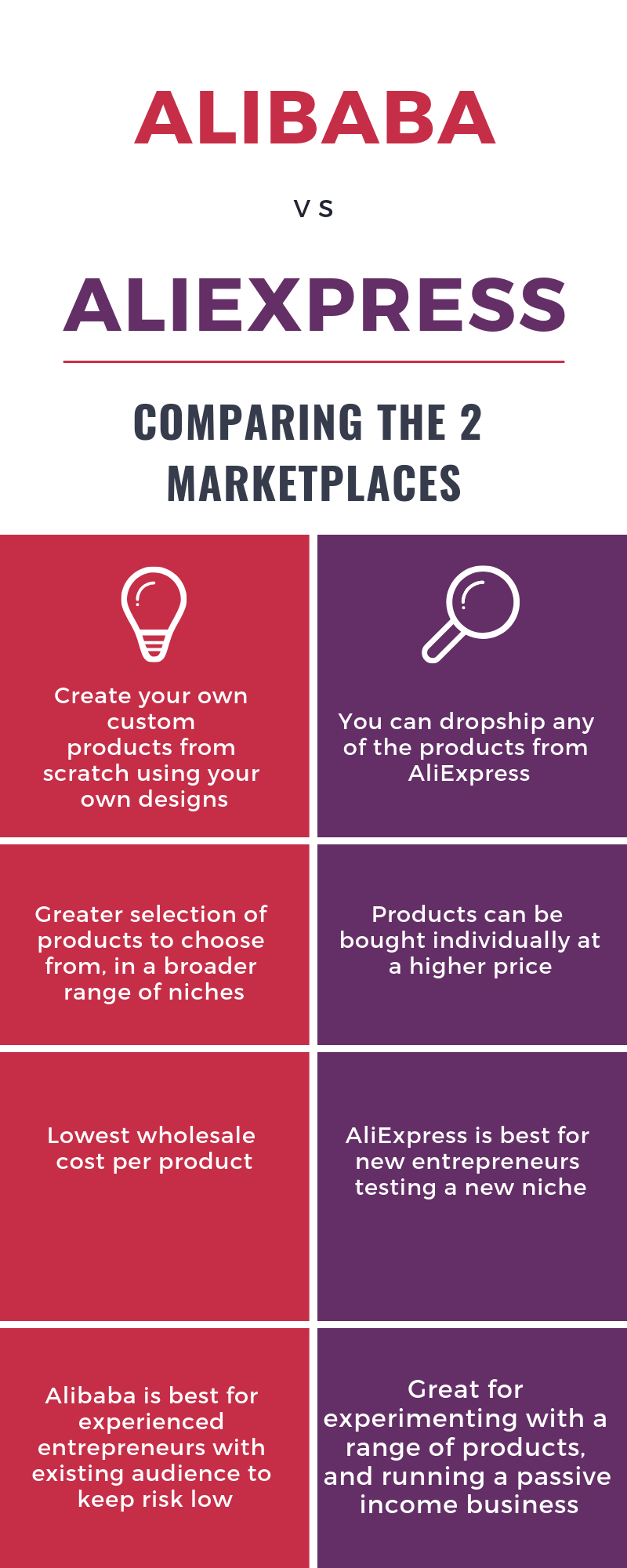
AliExpress Benefits
- You can dropship any of the products from AliExpress. So, you there’s no need to carry inventory, buy products in bulk, making it a low-risk business.
- Manufacturer’s can ship products to your customers for you on your behalf, at a lower cost than traditional international shipping.
- Products can be bought individually, so you can buy the exact number you need.
- AliExpress is best for new entrepreneurs who are interested in: testing a new niche, experimenting with a range of products, low-risk businesses, and running a passive income business.
We wrote a huge guide on buying products from Aliexpress. You can check that out here.
Alibaba Benefits
- Greater selection of products to choose from, in a broader range of niches
- Create your own custom products from scratch using your own designs
- Lowest wholesale cost per product
- Alibaba is best for experienced entrepreneurs who: want to sell their own custom products, have the lowest prices, want to have a competitive advantage, and have an existing audience keeping their risk low.
Aliexpress vs. Alibaba vs Alibaba Wholesale
Like we mentioned above, you have 3 options when buying products on Alibaba. The option you choose will depend how far along in the process you are. The best price will always come from Alibaba. However, if you want smaller quantities then either Alibaba wholesale or Aliexpress are better options. We’ll show you the difference with an example.
Example: Charcoal Bamboo Toothbrushes (4 Pack)
We looked at all 3 platforms and found this toothbrush set and packaging. Our goal here is to point out the differences between the three.
First up: Aliexpress
- Price: $2.50
- Minumum Order: 1 Set
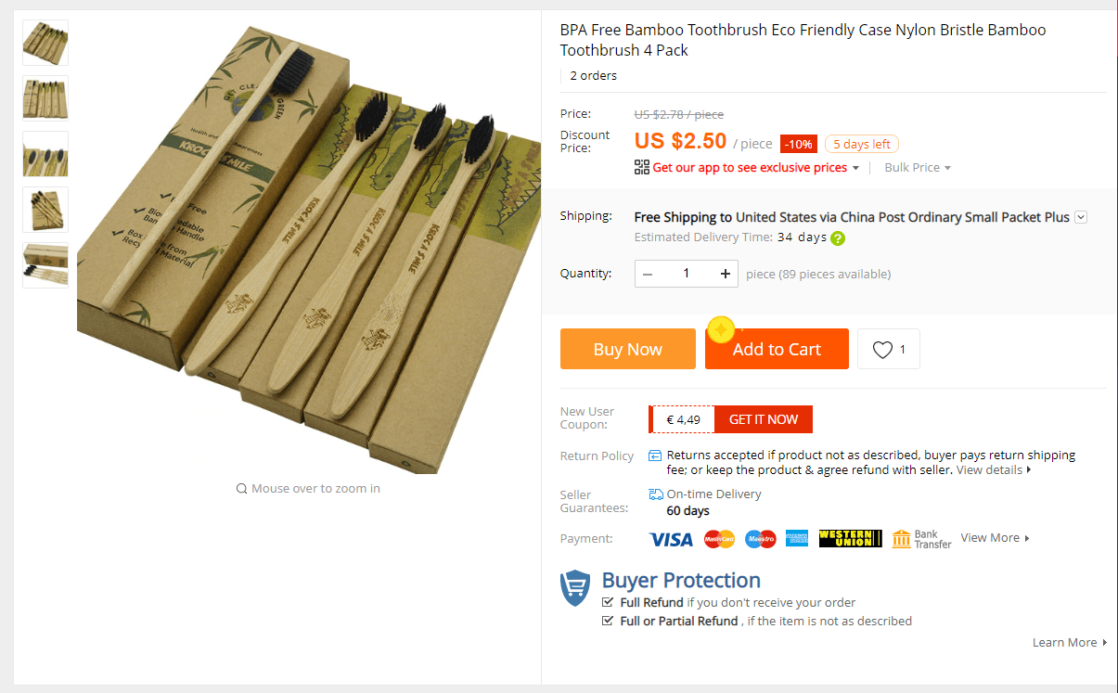
Next: Alibaba Wholesale
- Price: $1.68
- Minumum Order: 1 – 9,999 Sets
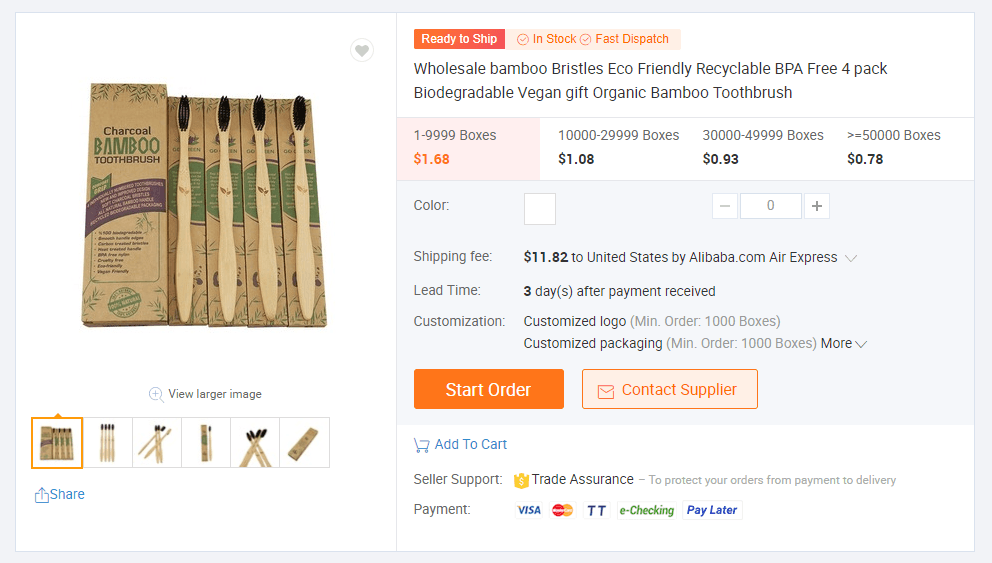
Next: Alibaba
- Price: $1.10
- Minumum Order: 1 – 999 Sets
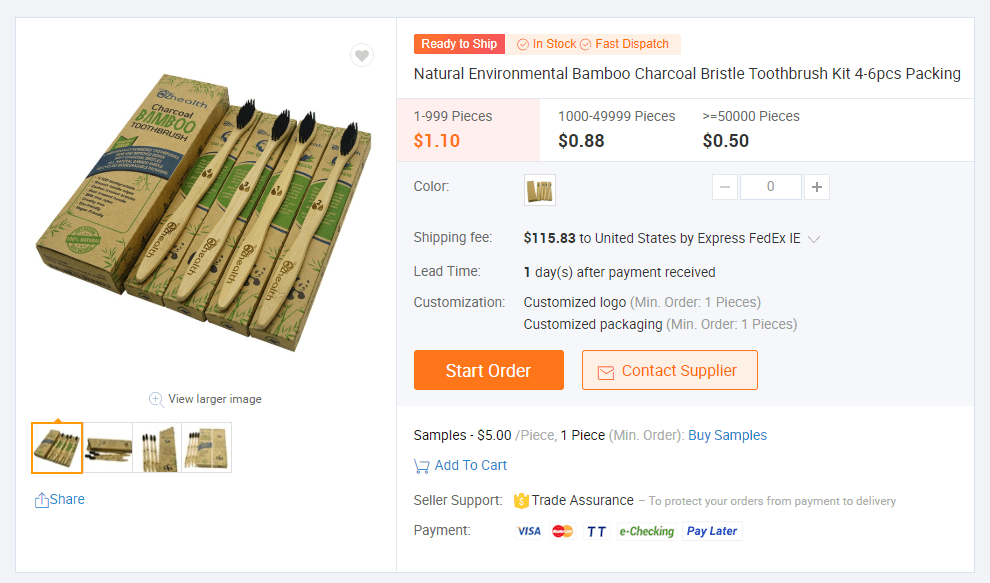
So what’s the final verdict?
Make a decision based on the goals you have. If you’re just starting out and want to test products with a small order then Aliexpress is for you. But if you want to start placing larger orders then Alibaba wholesale is the better option.
Once you have established yourself and you want to maximize your profit move over to Alibaba and place the biggest orders you can. Each platform is designed to meet you where you are in your business journey.
**Alert**
Something that bothers me is when our readers lose money or have bad experiences using Alibaba or Aliexpress. I want to try and put an end to that. That’s why we partnered with
Check Out The Supplier Database
Alibaba Vs. Amazon
Alibaba and Amazon are the two biggest ecommerce websites in the world. These are the main differences between Alibaba and Amazon from an entrepreneur’s perspective.
Alibaba is a wholesale directory where businesses find products and Amazon is the online storefront for businesses to sell their products.
Alibaba Features
- Products can be bought at wholesale prices and then sold on platforms like Amazon, eBay, Shopify, or even Instagram
- Due to lower product pricing, entrepreneurs can make a higher profit on products sold
- Products on the platform are non-branded, so entrepreneurs can create their own brands
Amazon Features
- You can sell your products on Amazon but products aren’t typically sourced from there
- If you don’t have your own business but want to sell Amazon products, you need to be accepted into Amazon Associates. You’ll receive a commission for selling products. However, as an affiliate program, entrepreneurs can’t set their own prices
- As an affiliate, entrepreneurs can sell brand name products on their online stores
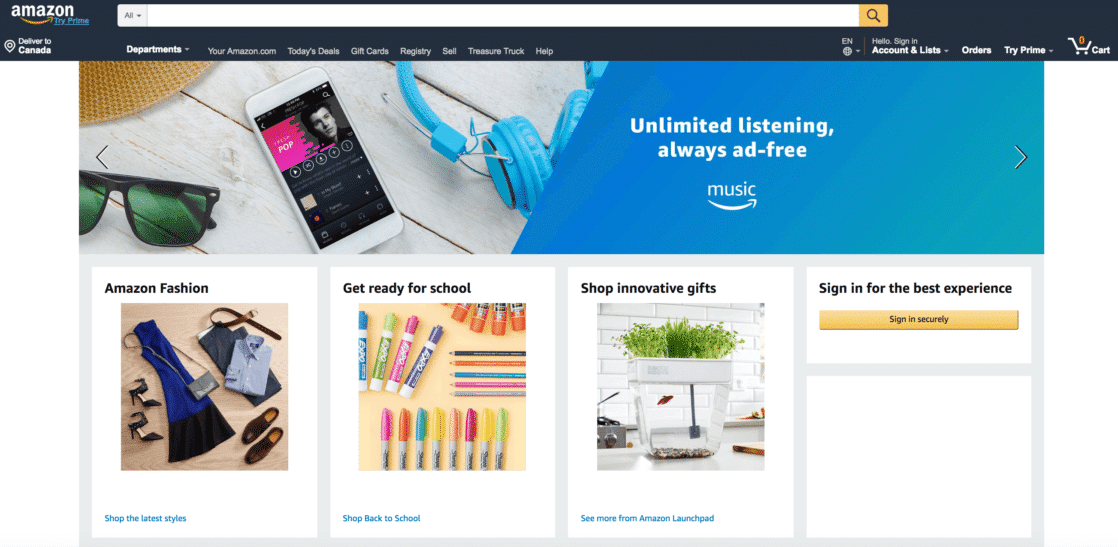
How Does Alibaba work?
Alibaba is a marketplace for a business or individual to buy products at wholesale prices directly from manufacturers. It’s generally not an online store for the average person.
First, an entrepreneur needs to determine their niche. By choosing a niche, an entrepreneur can find a product category to browse.
Alibaba has a range of product categories from Apparel, Textiles & Accessories to Machinery, Industrial Parts & Tools.
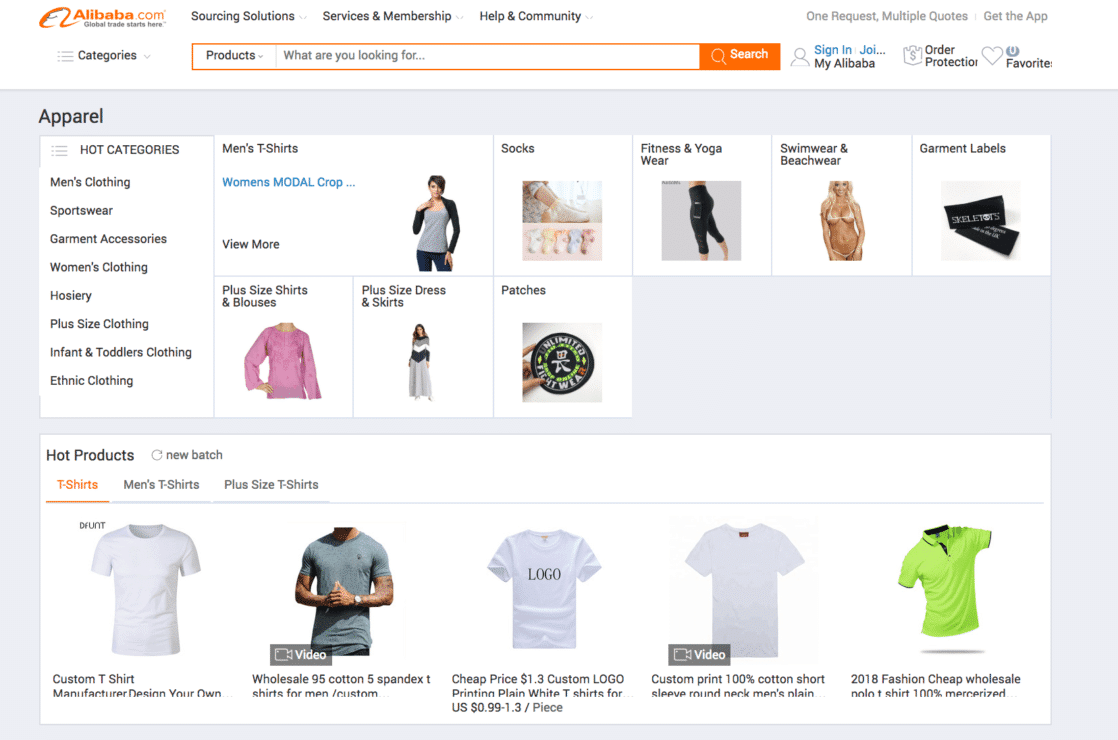
Once you find a product you want to buy, you’ll need to reach out to several suppliers. In your conversations with suppliers, you’ll want to do 3 things:
1. Evaluate their responsiveness.
2. Negotiate prices.
3. Building a strong relationship with them.
You’ll agree on a price, then you can place your order. The inventory will arrive shortly afterwards and you’ll be able to start selling online.
In the next few sections, we’ll be doing a deeper dive into the entire process.
Can Anybody Order from Alibaba?
Yes, anyone can order from Alibaba. Alibaba is the largest supplier directory where a single person can order directly from a manufacturer. But remember that Alibaba doesn’t make anything, they feature manufacturers who will work with both individuals and companies.
They’re essentially an online directory for manufacturers that you can reach out to and buy products from. You can negotiate price, minimum order quantity, shipping options and even sample prices.
Pros and Cons of Buying from Alibaba
Pros of Buying from Alibaba
- Alibaba has the lowest wholesale pricing allowing you to make a higher profit.
- There are millions of products within an extensive selection of niches.
- The ability to design your own custom products, affordably.
- Easily assess reputable suppliers based on their Supplier Type, number of transactions, reviews, and response time and rate.
- You gain more control over your product packaging and shipping allowing you to provide a better customer experience
- You can monitor the quality of products before they are sent to the customer which can help lower refund rates
Cons of Buying from Alibaba
- The minimum order on some products can be in the hundreds. With a higher upfront cost, the risk is on the entrepreneur buying from Alibaba
- Entrepreneurs can face legal action selling brand name products from Alibaba as they’re not officially licensed.
- The product photos aren’t always what the finished product looks like. Thus, frustrating entrepreneurs who receive packages they’ll be unable to sell
- Some niches have their own obstacles that entrepreneurs face when buying from China. For example, in fashion, clothing sizes are often in Asian sizing instead of American which can result in clothing sizes that are too small for your key demographic.
- Upon arrival, some products you’ve ordered can be faulty or broken. Also, some entrepreneurs have challenges with product quality after placing their second or third shipment
- You can’t start selling the same day you place the order. This can add delays in your selling time-frame. Also, if you sell out of inventory, it may take some time before you’re able to restock products leaving customers frustrated
**Alert**
Something that bothers me is when our readers lose money or have bad experiences using Alibaba or Aliexpress. I want to try and put an end to that. That’s why we partnered with
Check Out The Supplier Database
Buying from Alibaba Without a Company
Follow these steps to open an Alibaba account without a company:
1: Go to Alibaba and click on “Join Free”
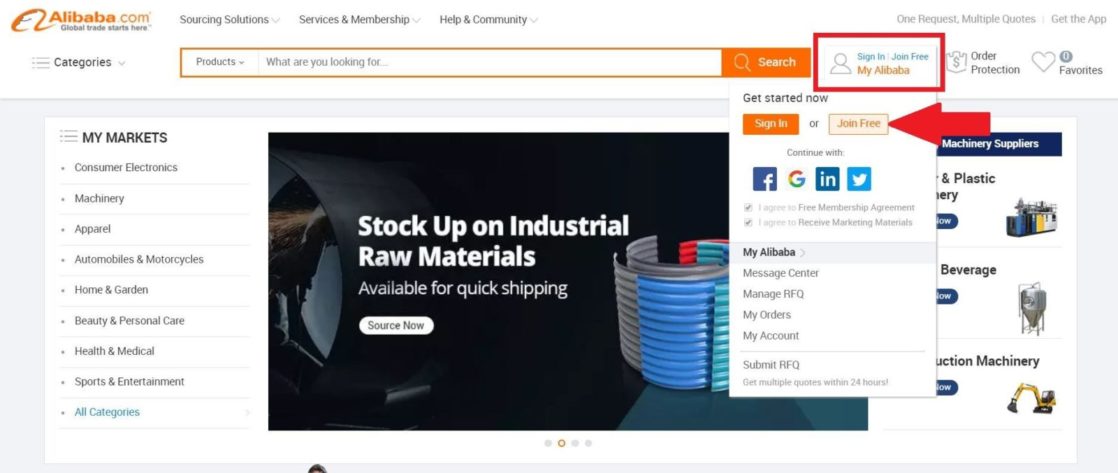
2: Enter your Email address and verify that you own it. Try to not use your main/personal email if you don’t want your inbox clogged up with supplier emails.
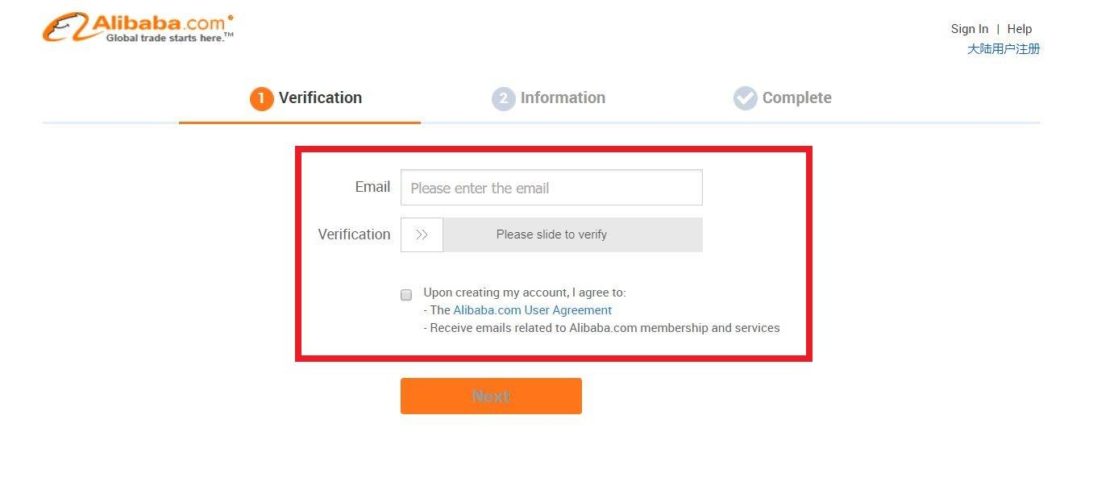
3: Fill out your basic information. Password, location, first name, last name, and telephone number. Alibaba asks you for “Company name”..Do not panic. The name can be anything you want, they will not ever ask again.
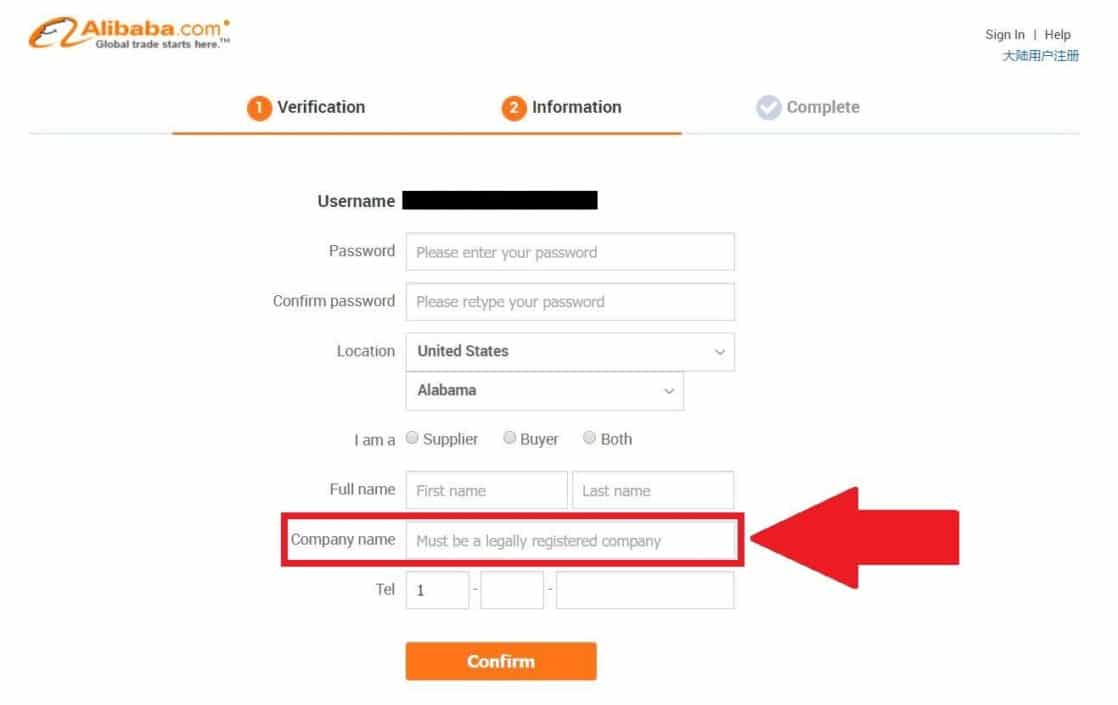
4: Confirm your personal information and complete the opening of your new Alibaba account. Now you can start buying products on Alibaba.
That’s it! You can now buy products and negotiate with suppliers on Alibaba.
4 Tips for Safely Buying from Alibaba
#1. Validate with AliExpress First
Before you go and make your bulk order on Alibaba, you need to make sure your niche and product are validated.
If you decided to create a yoga store, you might try dropshipping some products that you were interested in selling first.
Alibaba is best for experienced entrepreneurs who’ve already validated their products.
If you’re experimenting with Alibaba on your first try, you could be putting your business at risk, unnecessarily.
#2. Look for Reputable Suppliers
If you’re looking to have the lowest risk buying on Alibaba, you’ll want to check off all the boxes under Supplier Types.
- Trade Assurance: packages arrive on time and products are checked before shipment.
- Gold Suppliers: are pre-qualified, they need to pay a costly fee to attain this status which keeps scammers away.
- Assessed Supplier: the supplier was inspected by a third-party and includes a downloadable report.
While checking off these three boxes won’t protect you completely, you’ll be in a better position than if you were to randomly choose suppliers with no assurance.
You’ll also want to go over their ratings and reviews to determine their quality, performance and reliability.
#3. Don’t Buy Brand Name Products… Ever
Nike, Disney, and Nintendo require licenses to sell their products.
Unfortunately, while Alibaba often sells knock-offs of their products, selling licensed products can result in legal action.
There’s no exception to this rule. So don’t sell branded products.
Also, look out for products with exceptional designs. It can be hard to know all of the latest video game or movie characters. However, if a product design seems to be top notch, it may just be a licensed product.
#4. Hello Google
Before you even order a supplier’s products, some Googling will help you determine whether or not you should reach out to them.
You can use websites like Supplier Blacklist which has user-generated supplier complaints dating back to 2012 on international suppliers.
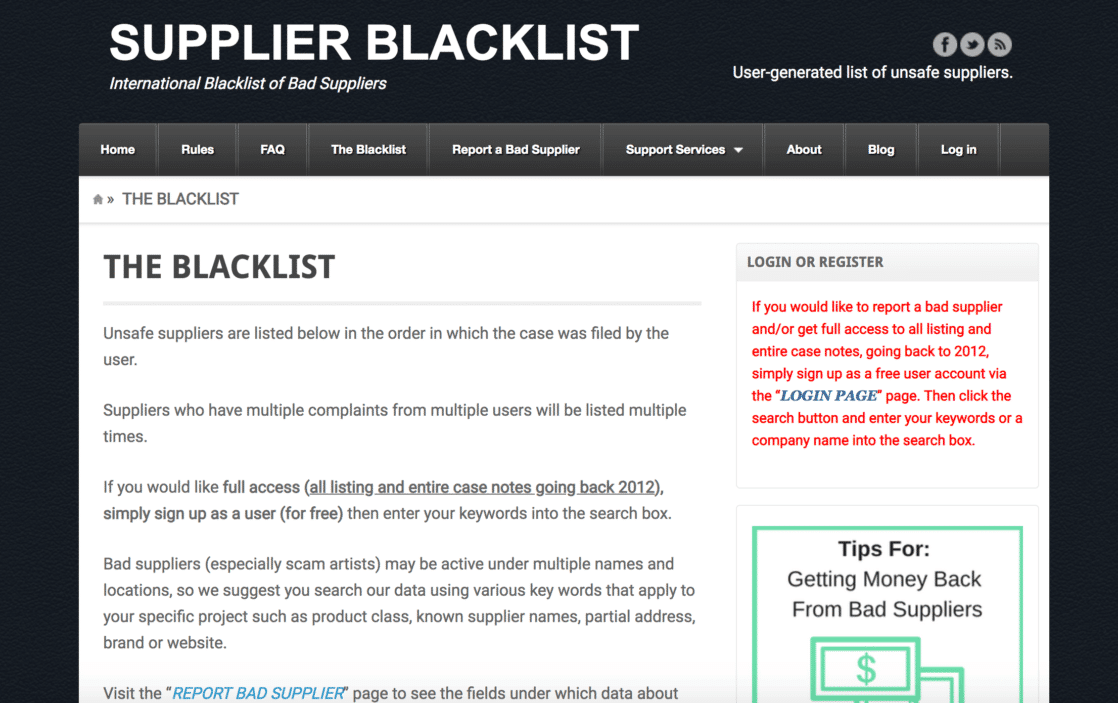
You can also type in your supplier’s name and words like ‘scam’ or ‘fraud’ to see the results on the page. But keep in mind that business, even yours, will one day get negative reviews.
So while you should read reviews carefully, it’s important to know the difference between a one-time disgruntled customer and a bad supplier.
Look for Common Red Flags in reviews, forums and in search results:
- First product shipment great, second shipment quality issues.
- Broken or defective products.
- Poor factory working conditions.
- Supplier asks for full payment upfront outside Alibaba.
- Super low product price results in low quality products.
Step by Step Process of Buying from Alibaba
Now, let’s do the deep dive into the entire process of buying from Alibaba.
First Step – Choosing a Niche on Alibaba
With so many product categories on Alibaba, it can be overwhelming to figure out what to sell. Ideally, you would’ve already validated your niche prior to buying from Alibaba.
You want to choose an evergreen niche because they’re reliable and benefit from having trends within them.
For example, in our last article, I mentioned that I was in the yoga niche. Yoga has a broad audience and has been reliably popular for years. I sold mandala blankets which some people used to meditate or practice their postures on.
Because I had an evergreen niche, I wasn’t tied down to a product and could diversify my product collections as needed. However, since the niche also has trending products I was able to capitalize… big time.
6 Methods to Find Niche Ideas
1. Keywords Everywhere
This Chrome extension tells you the monthly search volume, CPC, and Competition of a keyword. It helps you see how popular a niche is based on search activity. If you find a niche with over 1,000,000 monthly searches and low competition, you can scroll to see who are the biggest Google advertisers. And you can see top ranked websites for the keyword.
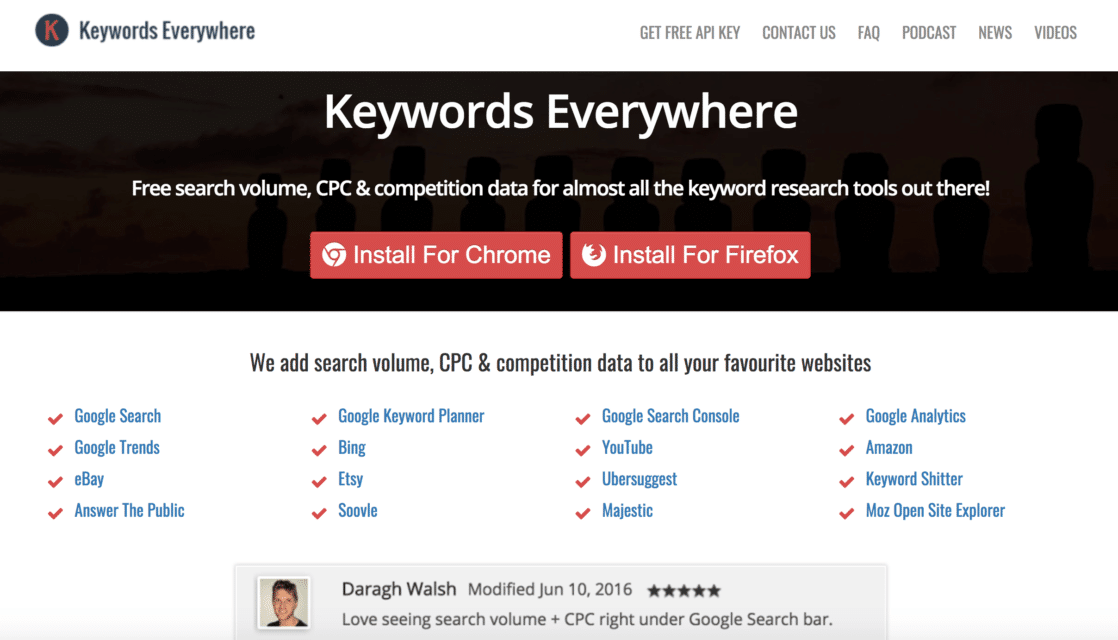
2. Amazon
When browsing Amazon, I like to try a variety of product categories to see the best-selling products. Sometimes, you’ll find random products that seem like they’d be a good fit for your niche. Some products from Alibaba are already selling on the platform, so you can see how well they fare on Amazon.
If they have a lot of positive reviews, be sure to look at the dates. Are people still buying the product or were they buying it months ago? This can help you indicate how viable the product is.
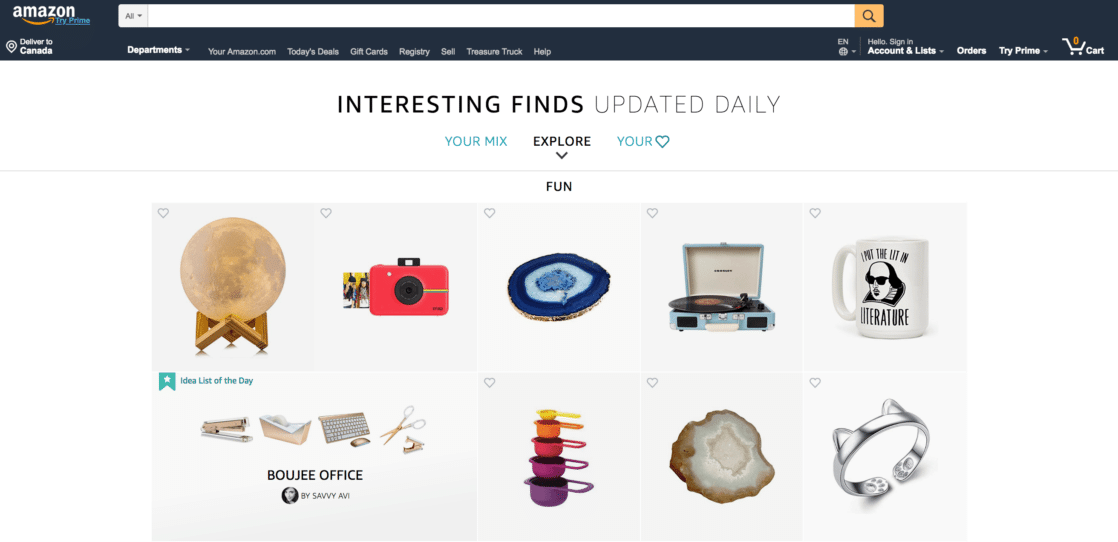
If you want more insight into product research using Amazon, check out the Startupbros article outlining the 3 Amazon product research tactics working in 2019.
3. Product Lists
Using search terms like ‘trending products 2018’ you’ll find a range of niche eCommerce product lists. The trending products on these lists usually belong to evergreen niches. Use these lists to help you find what to sell in your online stores.
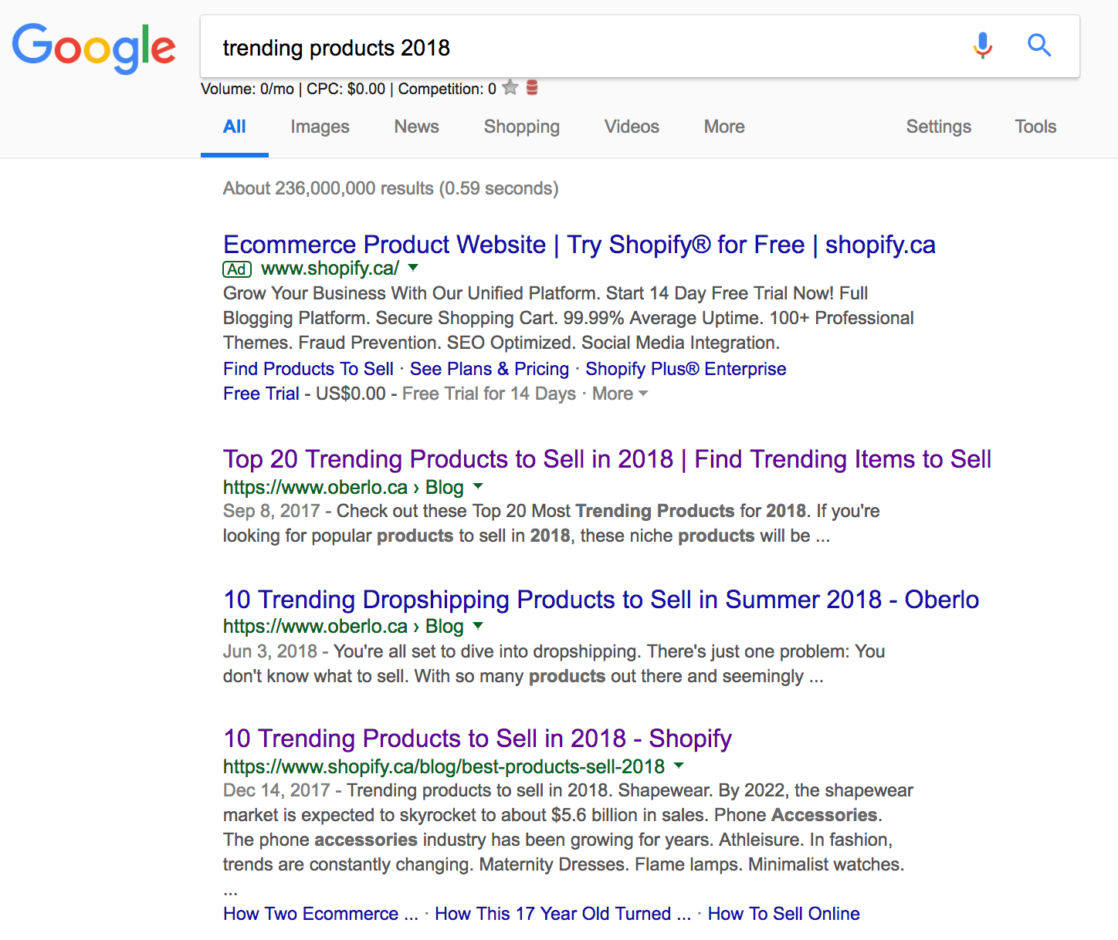
4. Trend Hunter
While trend hunter often features products from specific brands, you’ll find a range of product ideas that’ll help you see upcoming trends. The website doesn’t give you context as to why the product is a trend so do your research.
On their homepage, there’s a cauliflower pizza crust made by Green Giant. The context is that the most popular diets right now tend to be low carb. Food brands are now using cauliflower, beans and lentils in traditional carb foods like pizza and pasta as healthy and low carb substitutes.
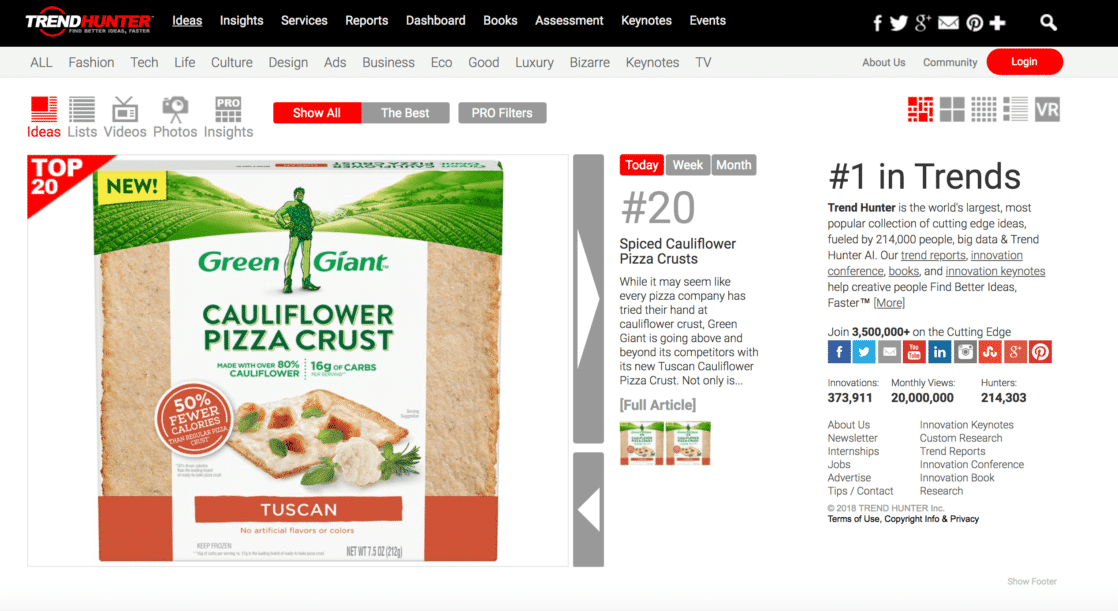
5. Google Trends
After narrowing down a list of ideas, you can cross-reference the niches on Google Trends. Sometimes trends are too new and don’t have enough search data to show up. Other times it may just not be popular enough.
On average, I like to stick to ‘2004-present’ to see the full lifetime span of the niche. If you stick to evergreen niches like fashion, you’ll see that that while there are seasonal upticks and dips, it generally remains pretty stable.
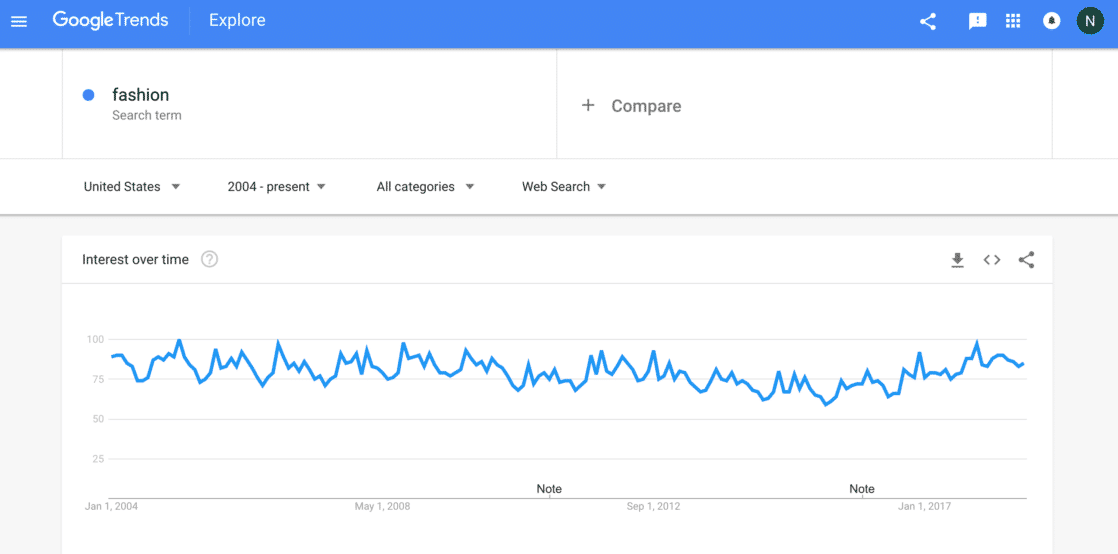
However, keep in mind that fashion is too broad a niche. Fashion retailers often niche down a bit. For example, women’s fashion, men’s fashion, maternity clothing, plus size clothing, children’s clothing, etc.
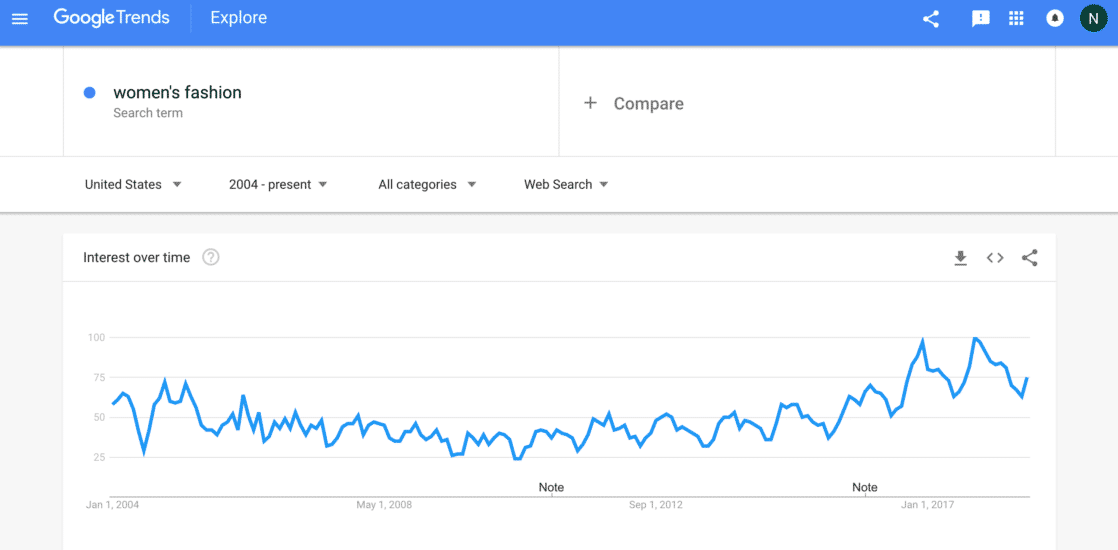
6. Twitter
Sometimes, when I can’t decide between the final two or three niches, I use Twitter polls to get feedback. I use hashtags like #ecommerce or #dropshipping so that people within the eCommerce community can vote on a niche. However, the real magic isn’t actually the response you get from the people.
Have you ever had someone else make a decision for you and realized you wanted the other option instead? If people vote for a niche you don’t actually want, your decision will become clearer. I’ve actually tried this in the past and it helped me make progress on a new store faster.
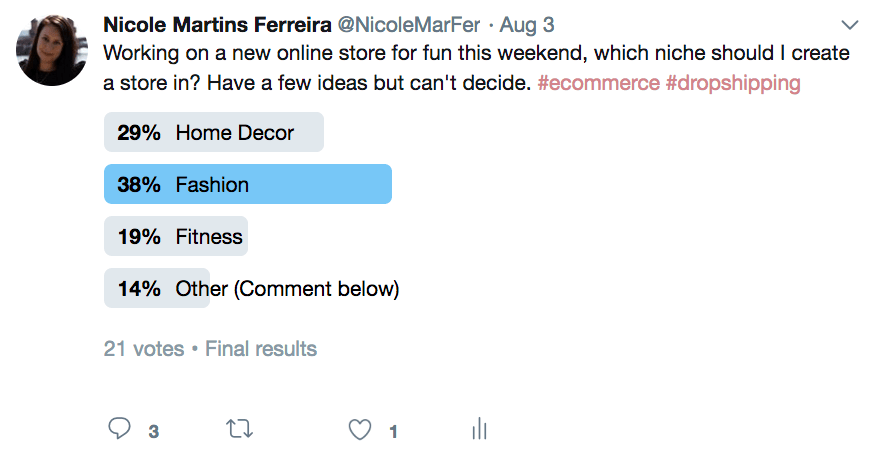
These are just some of the websites you can use to help narrow down your niche. Using a combination of all the websites tends to work best. When I plan to start a new store, I usually go through the entire list and narrow down a niche based on data from all these methods.
Second Step – Choosing a Supplier
While most entrepreneurs choose products first and suppliers second, some entrepreneurs find that choosing a supplier is the best way to go to have a consistent style on your store.
Many suppliers offer a range of products that you can sell. It can also be good to have one or two core suppliers so that you can strengthen your business relationship, ensure you have a reliable supplier and a cohesive product collection.
1. Run a Suppliers Search

2. Type in the Product You’re Looking For
For example, if you’re looking for fashion, you wouldn’t type in fashion as it’s too broad. However, maybe you’re looking to sell cocktail dresses for a women’s fashion store. So you type in ‘cocktail dresses’ to ensure that the suppliers carry that type of product.
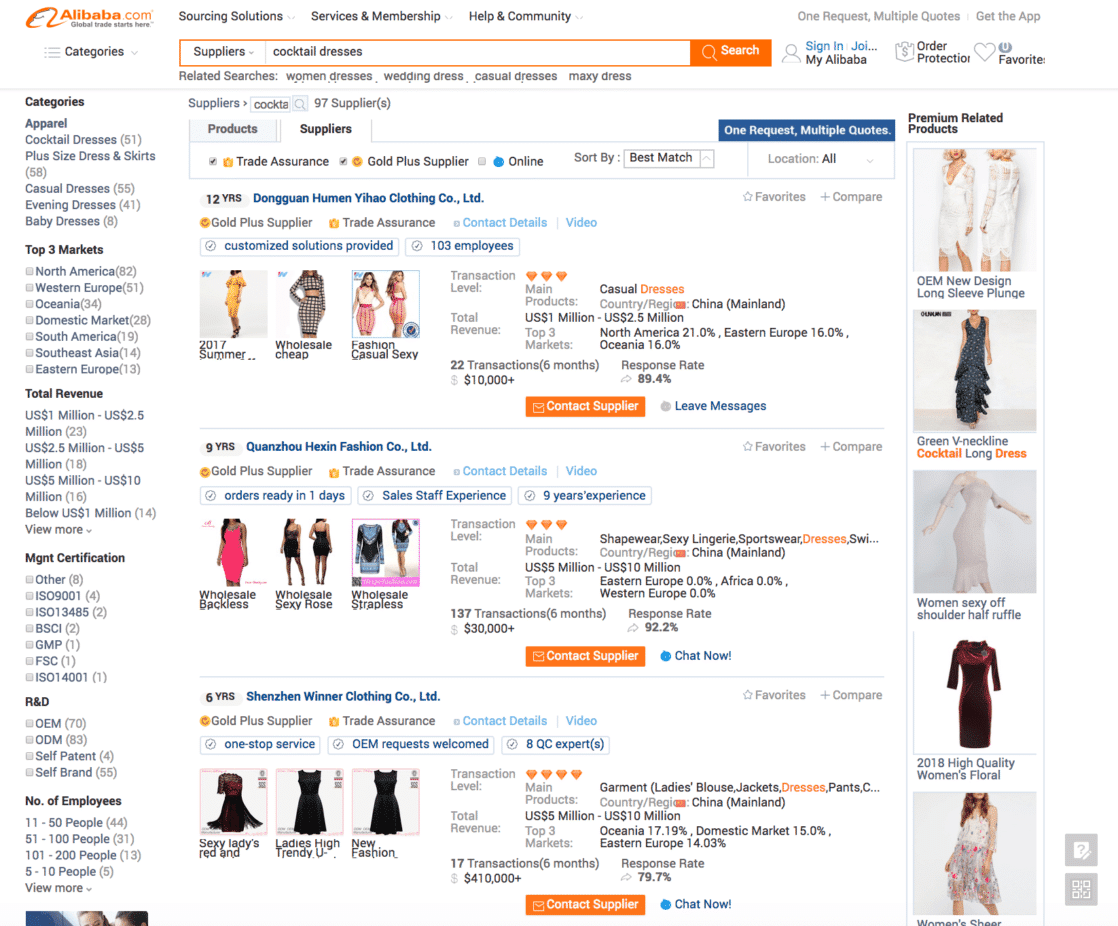
3. Narrow the Search
You can then further narrow down your suppliers to include only Trade Assurance and Gold Plus Suppliers.
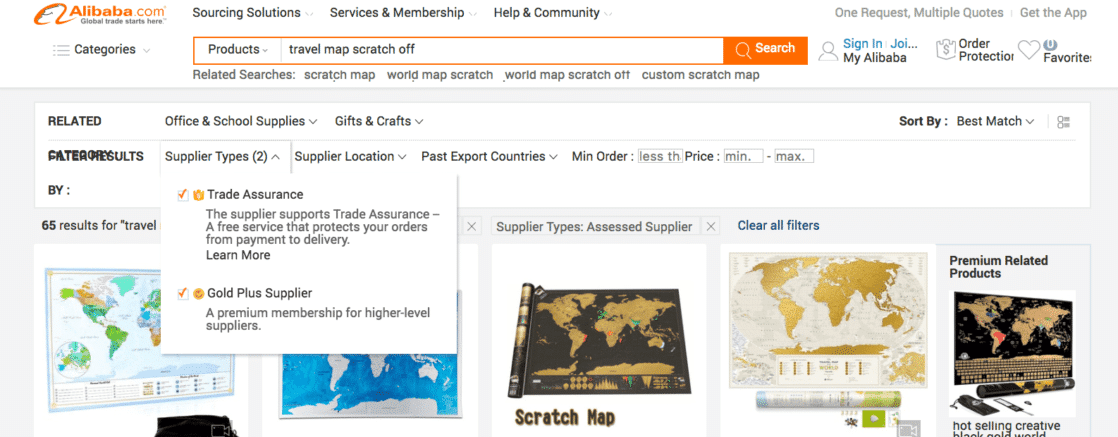
Next, under Sort By you can either leave it as Best Match or change it to Transaction Level or Response Rate. Transaction level is a great option if you’re looking for a supplier who’s processed a lot of orders.
Response rate is good if you’re looking to build a relationship with a supplier. It all depends on what your needs are in your dealings with the supplier.
Now, you’ll need to do some work looking up the suppliers that seem to have the types of products you’re looking to carry on your online store.
4. Individually Check Each Supplier
**Alert**
If you want to check it out, it’s right here.
Check Out The Supplier Database
You can click on the supplier’s page which details information like their company bio, response rate and time, transaction level, factory inspection reports, and their main products. You can also send messages to the supplier at the bottom of the page.
When choosing a supplier to work with these are the things you want to look for:
- What are the working conditions like at the factory?
- Are the products they carry what you envision selling?
- Is the rating for product quality above 4 stars?
- How many transactions have they had in the past six months? This can indicate how popular their products really are.
- How many employees are working at this factory?
- Do the product photos look like they were taken in-house or stolen from another online retailer?
Keep in mind that no matter how much due diligence you do, there may still be issues that arise in your relationship with your suppliers.
Third Step – Choosing a Product
With millions of products to choose from it can be daunting to navigate Alibaba’s website to pick products that you want to sell. While you were picking a niche, you might’ve seen recurring patterns of the types of products you should sell.
For example, say you run a travel blog that you now want to monetize with travel related products. You might’ve noticed that scratch off travel maps have been really popular. So you decide to search for them on Alibaba.
As you scroll through, you see that Alibaba has various travel maps with different styles.
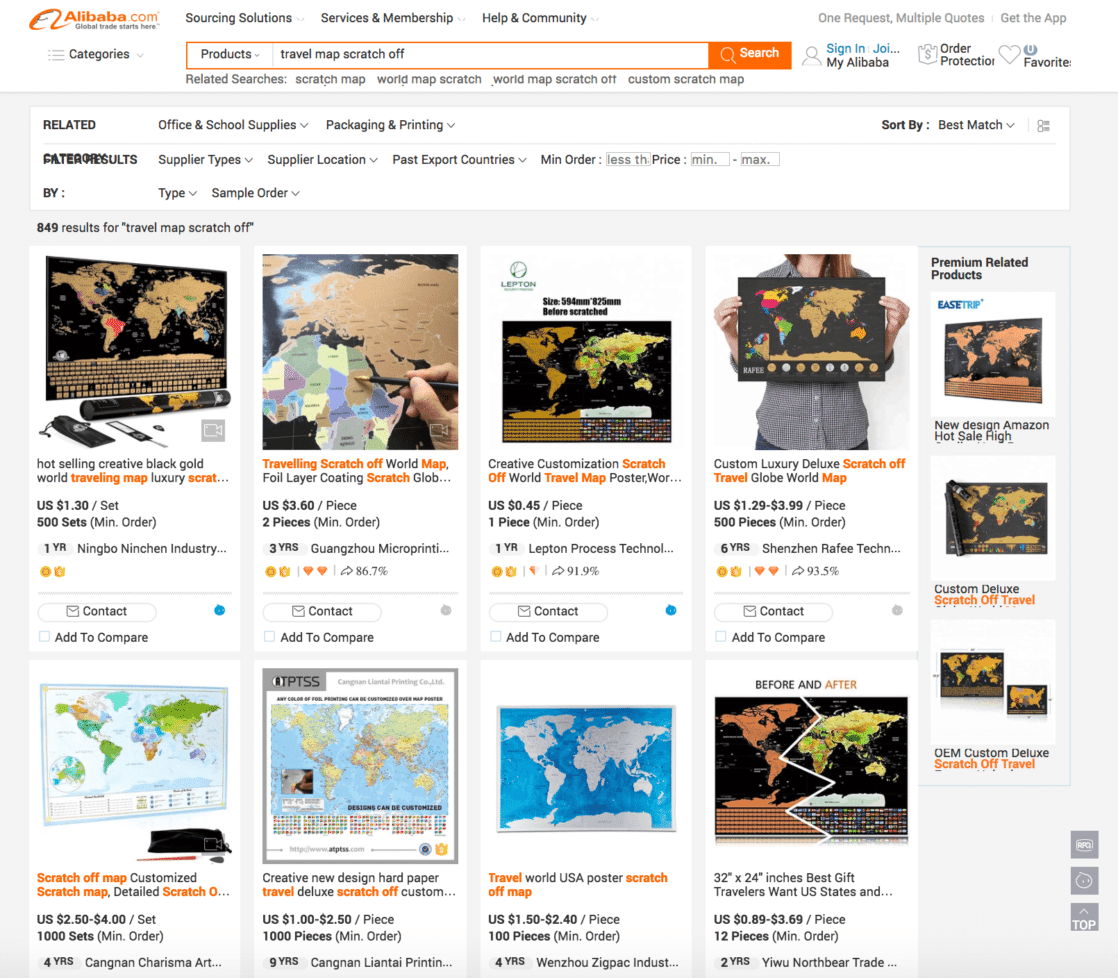
…But how do you know which one to sell?
Match products you’ve researched to factories on Alibaba. If you want to check it out, it’s right here.

Check Out The Supplier Database
#1 – Minimum Order Quantity (MOQ) vs. Price
Some travel maps require a minimum of 500 maps ordered while others only require one. Do you stick to the ones with the lowest minimum quantity or do you just ask for samples of the products with higher quantities?
You’ll notice that some of the travel maps look the exact same but are sold by different suppliers and at different prices. In the past when I’ve ordered from AliExpress, I’ve made the mistake of buying products with the lowest pricing.
At the time I was selling a blanket. Unfortunately, the product with the lowest price had the thinnest material and resulted in countless complaints. However, when I chose a higher priced version of the same product it had a thicker material which customers loved.
The key lesson here is never base your decisions exclusively on product pricing. Lower pricing often means lower quality.
So, back to these maps.
#2 – Select the Right Supplier Filters
You can start using the filters on top to narrow down your options. Because let’s face it with 849 products to choose from, there’s too much variety to sort through.
Under Supplier Types, you might choose Trade Assurance and Gold Plus Supplier to lower your supplier risk.
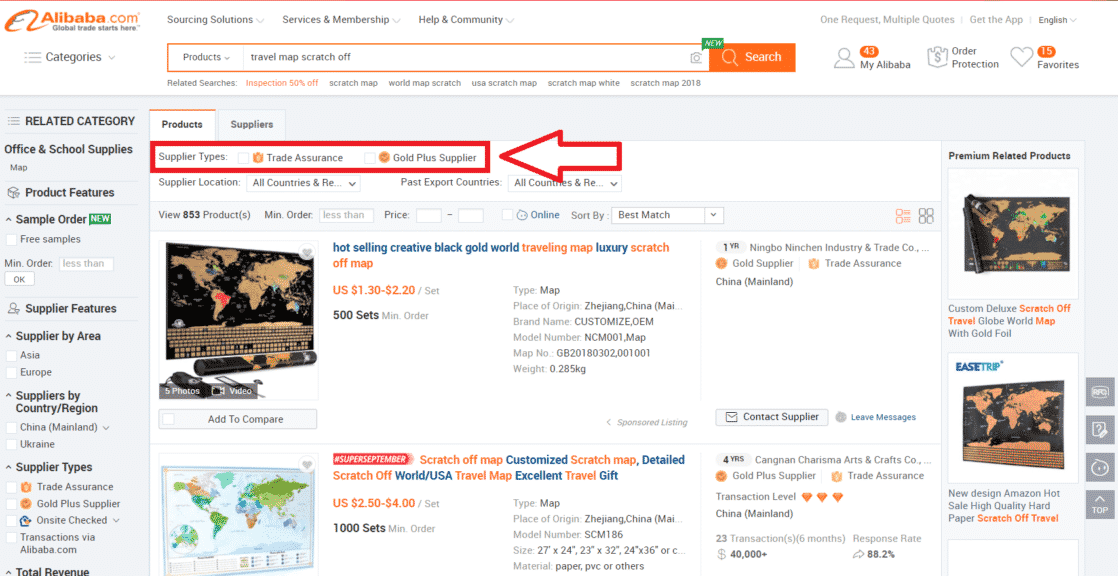
Look at Past Export countries, you might choose your country to make sure they ship to your region.

Where it says minimum order (Min Order), you can set a quantity your most comfortable with paying for. For example, ordering 500 minimum at $2.40 a piece can set you back $1200. Maybe you only have a budget of $500 so you add in a minimum order number of 100.
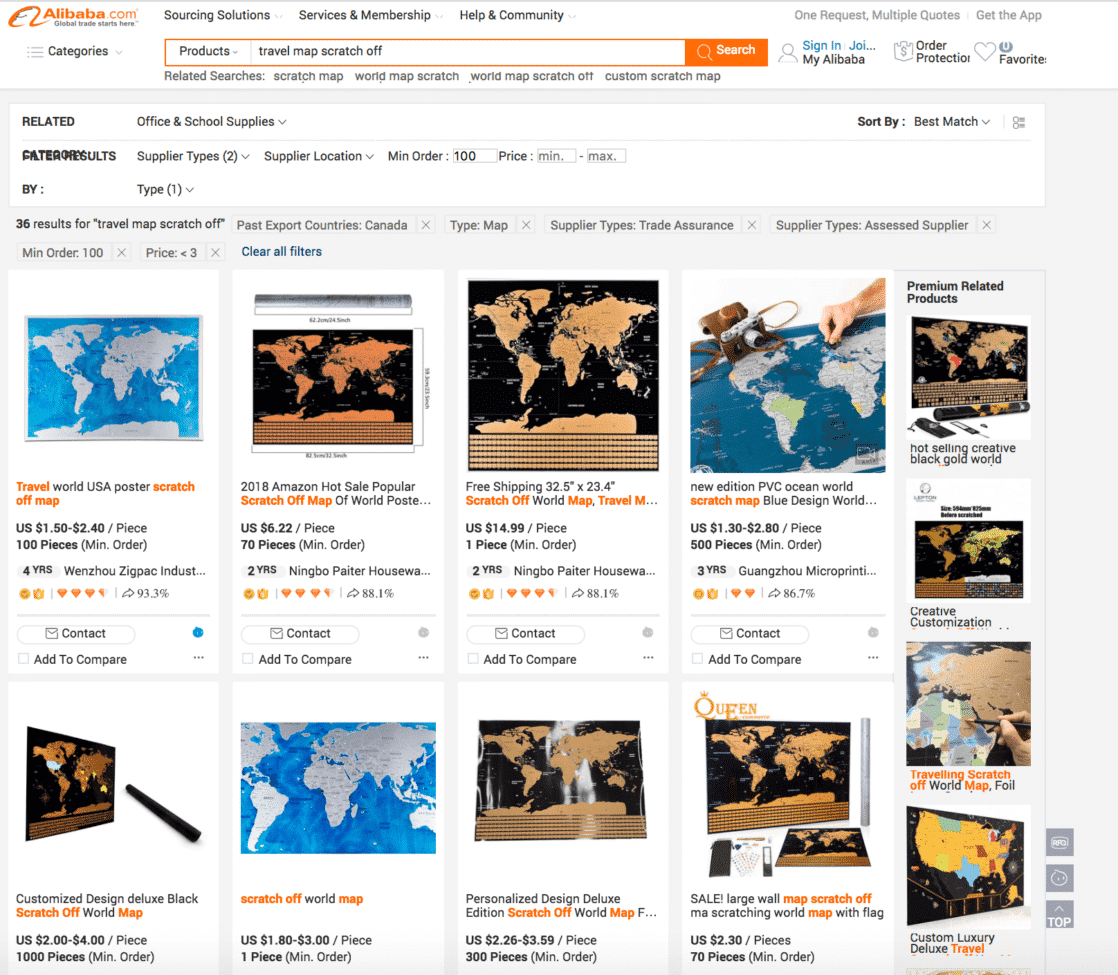
Your product listing results end up with 36 listings. And a quick browse of it shows that some of the products listed don’t meet the minimum order set making the product pool even smaller.
There are about 20 products to choose from. You can narrow it down further by choosing the top five styles you think your audience will like. Then, you can move onto the next step and contact suppliers for samples.
You can use the samples to take product photos and validate which product is best at converting the sale so you know which product to end up order the bulk quantity for.
Fourth Step – Contacting Suppliers from Alibaba
When you land on a product page, there’s a large, orange button labelled ‘Contact supplier’ which allows you to reach out to the supplier before placing your order.
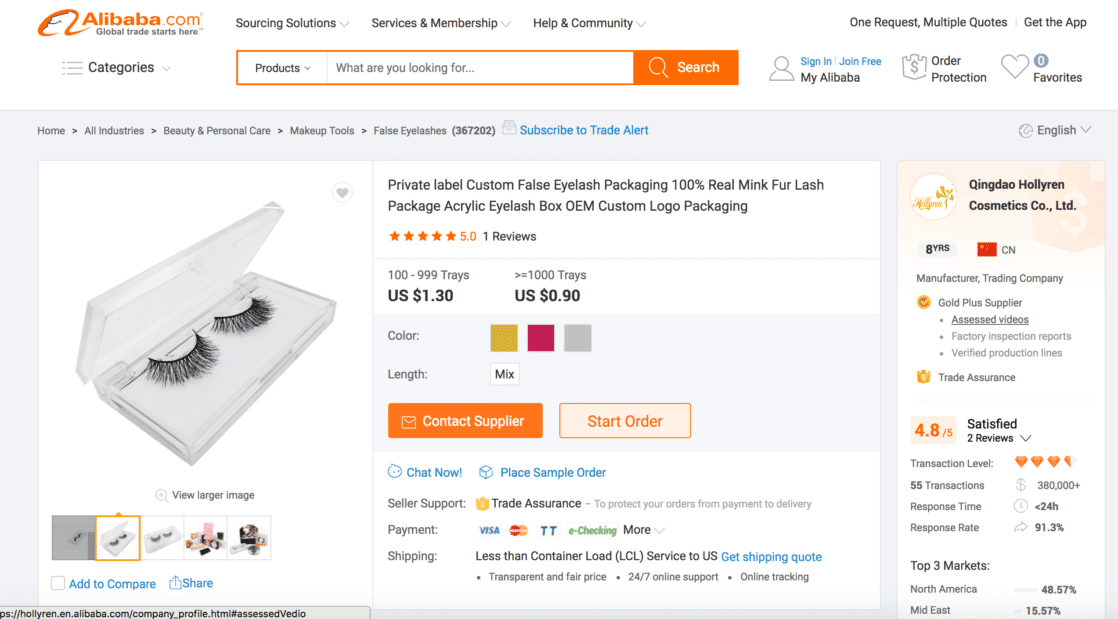
You don’t need to reach out to the supplier before you start your order. However, it can be a good idea to ask some questions to get further clarification on the product.
Here’s a sample of what you can ask in your first message to your supplier:
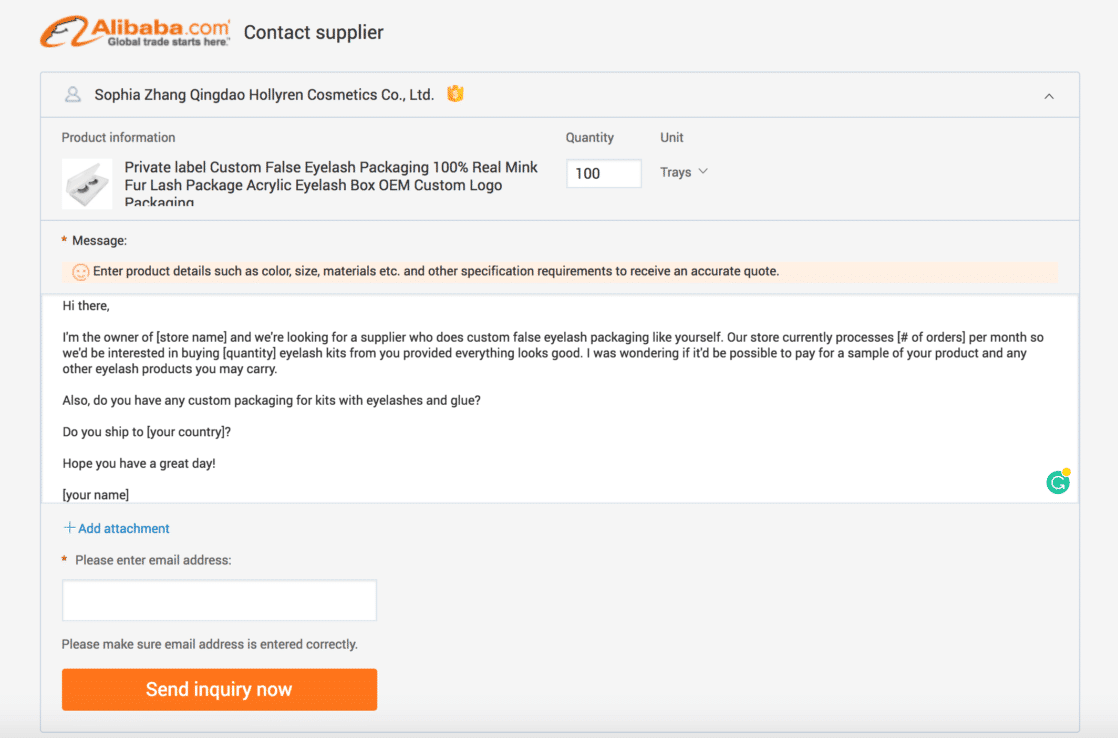
First Message:
Your first message should be an attempt to get a sample to do a quality check on your product. For example, if you were selling fake eyelashes, you’d use the sample to try on the eyelashes.
Does the product cause irritation? Does it last a few hours or does it fall off before the end of the night?
Some entrepreneurs hurry the process and avoid getting the sample.
However, not all products are made equal. It’s tempting to buy the cheapest product to cut costs. Yet, cheaper cost usually means cheaper quality.
And the sample you get will either show you that you’ve chosen a good product or you need to find a different product from another supplier.
If you’re happy with the product sample you order, you can send your supplier a second message.
Second Message:
In your second message, the focus should be on negotiating prices, sending details such as logo for custom packaging, including your shipping address, and asking shipping related questions.
When it comes to negotiating prices, wait until the supplier sends you the total cost. For example, if the total order comes out to $522.98, you can negotiate to bring the cost to an even $500 for the total order. Or if you’re looking to lower your cost per product, you can offer to order more products in return for a better per product price.
Keep in mind that these conversations should help you better understand what you’re buying and who you’re buying it from. So treat your suppliers on Alibaba as you would a business partner because they can be some of your biggest allies when it comes to building a successful brand.
Match products you’ve researched to factories on Alibaba. If you want to check it out, it’s right here.

Check Out The Supplier Database
Fifth Step – Checking Your Order
Once your products have arrived, you need to assess the quality of the products.
Here are some tips when examining inventory:
#1. Examine and test every product
If you sell apparel, look for any rips or tears to clothing this is especially important for lace apparel. For clothing, you’ll also want to double check the measurements to make sure they’re the right size.
If you sell any products made of wood, felt or sticky material check to make sure there’s no dust or dirt on the products. You might also want to check for any ink stains.
You’ll also want to check to see if each product has every component. If you’re selling products with multiple pieces, you need to make sure every product has every piece with it.
#2. Do a Count Check
If you ordered 300 products, you need to do a count check to make sure you received all pieces. This can sometimes be a problem for higher order volumes.
When you only order 5 pieces, it’s often noticeable if one’s missing. But if your inventory is in the hundreds or thousands, you or someone on your team need to check that you received everything you paid for.
#3. Examine Product Packaging
While you likely want to have your products packaged in your own custom packaging. You might still want to pay attention to how your products were packaged.
Here are a couple questions you may want to ask yourself:
- Does each piece come in a plastic, bubble wrap, or box?
- Were items packaged securely? (This can be a red flag depending on how they arrive)
- Based on the packaging you received, what’s the best packaging for your customers?
#4. Put Out Any Fires
After examining the quality of the products, is there anything you need to do next?
For example, if you receive clothing but it’s wrinkled, you may want to steam the apparel before shipping it out to your customers.
Are there any products that are too damaged to sell? You may want to reach out to your supplier or Alibaba for a refund.
13 Sites to Sell Products from Alibaba
#1. Shopify
As an eCommerce platform, you can build your own brand and sell from your own website or pop-up shop.
Plus, there are apps you can install on your store which allow you to sell your products on Amazon, eBay, Etsy and Instagram.
You have control over your own product pricing and don’t need to compete with other vendors.
While you have to do your own marketing, you’ll be able to build your own email list, social media followers and more. Your customer list is owned by you.
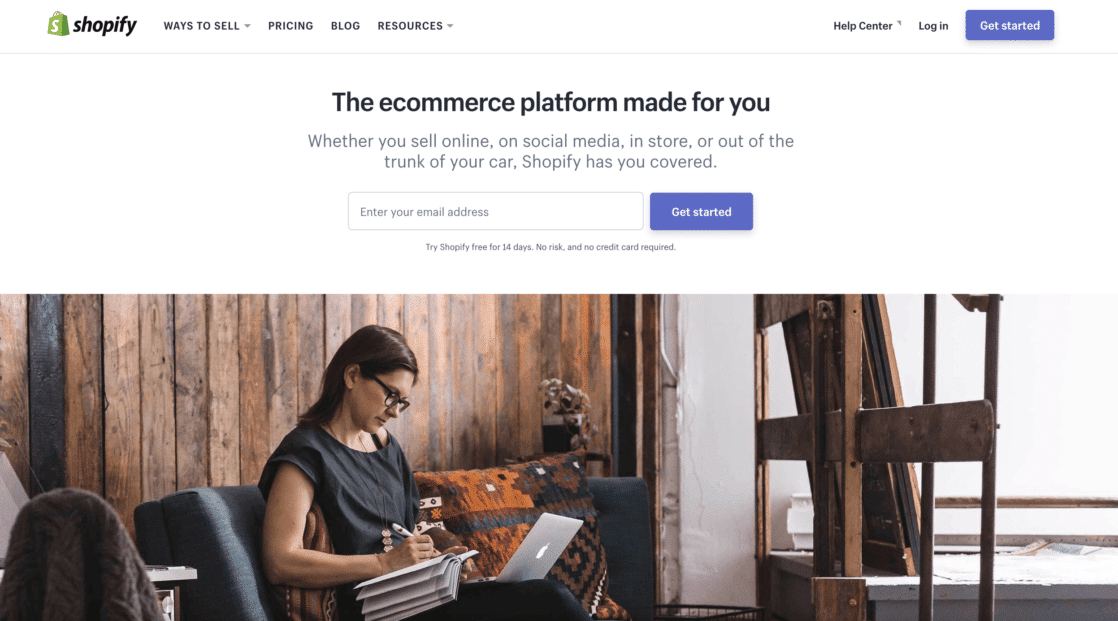
#2. Amazon
Amazon is one of the most popular websites to sell products online, especially from Alibaba. Millions of people buy from Amazon’s website everyday making it more likely that customers will find you.
You’ll benefit from having Amazon market your products for you.
The downside is that while you won’t have to worry about marketing, you won’t own the customers who buy your products. So, you’re prevented from remarketing to your customers via ads, email or other marketing assets.
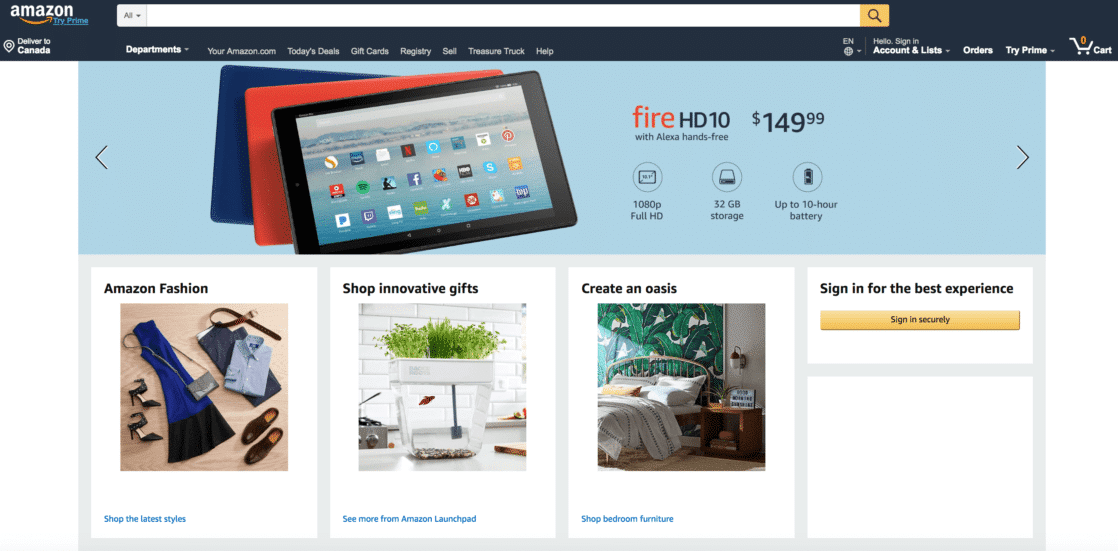
#3. Facebook Groups
Facebook groups are a hidden gem for finding people to sell to. First, you can browse the Buy & Sell groups for your city allowing you to sell your products locally.
It also helps you keep your shipping costs low as you won’t need to pay for shipping fees if they pick-up your products in person.
You can also try to sell your products in niche Facebook groups with the permission of the Admin, or else you’ll get banned.
But you can also create your own Facebook group so that you can occasionally sell products to people who join. Depending on where your members live, you may need to pay shipping fees for this.
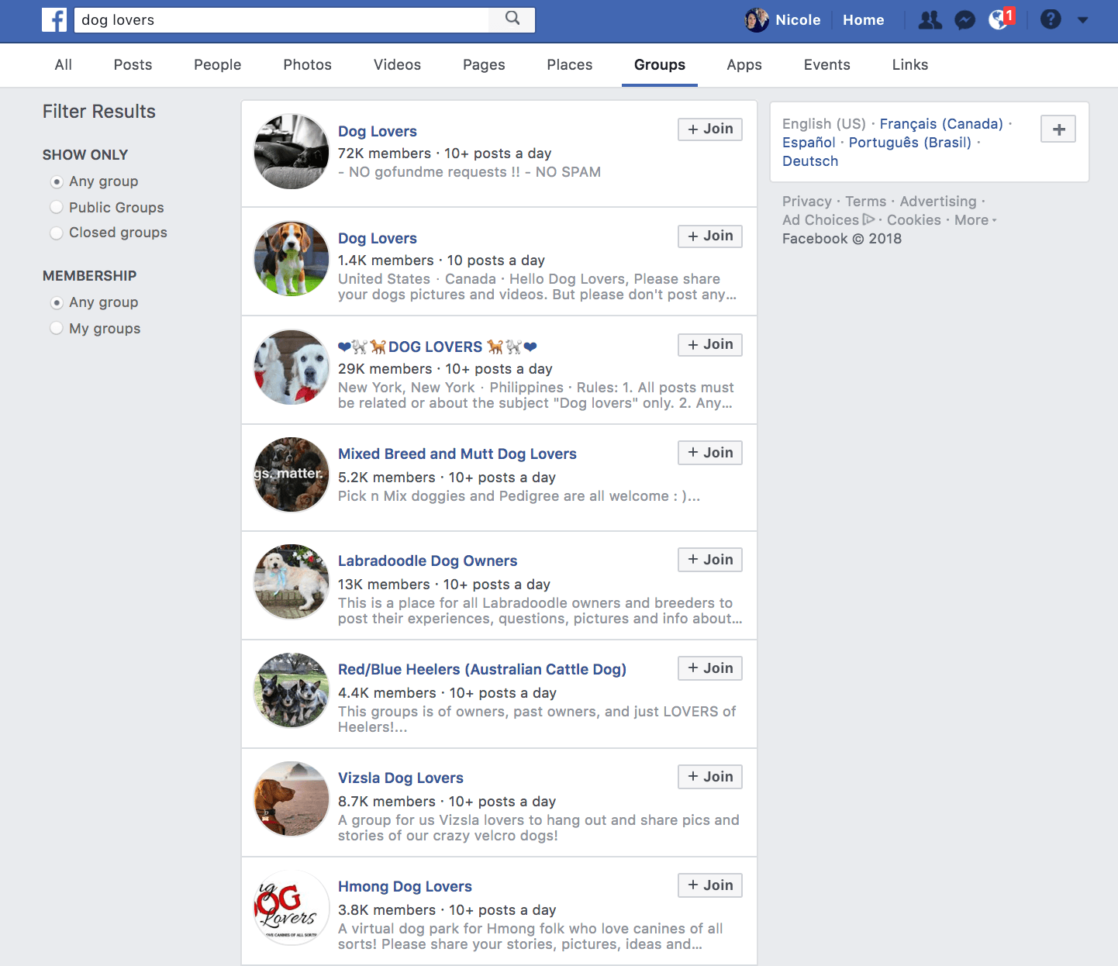
#4. Marketplaces
Here are a few marketplaces you can also sell your products in:
Conclusion
Buying from Alibaba can be a great way to sell products online, affordably. While there is some risk with selling products from Alibaba, entrepreneurs can take steps such as doing careful research before working with a supplier.
Ultimately, you need to decide if Alibaba is right for you. If you’re just starting out on your entrepreneurial journey, you might choose to dropship products from AliExpress instead.
However, if you’re looking to design your own products or cut down your product costs, Alibaba may be a better alternative.
We partnered with
Check Out The Supplier Database
Special Offer…
For 2020 we’ve completely updated and launched a brand new Amazon business course that teaches first time entrepreneurs how to launch their very own physical product Amazon business fast. Negotiating, import taxes and buying on Alibaba is a big section on the new course. If you want to check that out and see if it’s right for you click here…

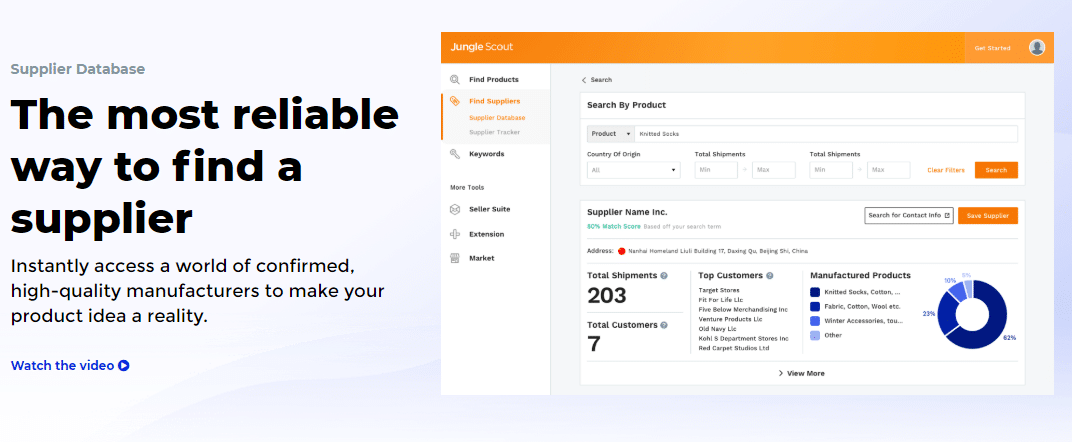
Some of info is actually not correct. You can buy American branded products on Alibaba. This started in 2019 when Alibaba opened up the platform for America Brands to sell.
I want to order as a private (not business) person. Can you confirm that’s definitely possible please? I need some big numbers of certain items that I already know the quality of.
You can register and place orders as an individual or a business (on both Alibaba & AliExpress). The platforms themselves now handle Sales Tax Permits, so you can eventually input that to save money on taxes when purchasing inventory. You’ll be hard pressed to find a Chinese supplier who cares about your US legal entity. They just want to sell products.
Are the manufacturers (suppliers) on Aliexpress the same ones you will find on Alibaba? I noticed in the article it said you can order and test small quantities from express before ordering large quantities from Alibaba.
AliExpress is a consumer platform, Alibaba is a business platform. Many times you will find the same exact suppliers on both platforms. If the same factory does not exist on both platforms, then almost certainly there are resellers selling the factory product on AliExpress.
So can you find the product you want on AliExpress? Probably. Should you be buying samples there (rather than Alibaba)? Depends on your situation. I personally almost always just use Alibaba.
I’m interested in purchasing a single small rice combine whose cost is roughly $5000. Mfr wants 40% up front and the rest upon shipment.
Is this typical?
Also, they say they can ship within 10 days but might I be waiting months due to supply chain snafus? ( shipping to east coast USA )
I’m not exactly sure how a normal conversation should go when you’re first contacting a supplier. I just don’t know the important questions to ask and obviously i want to seem professional and decently friendly so when/or if I negotiate on a price obviously I can’t expect they to budge if they think I’m just some greedy drop shipper just trying to make a buck. Or maybe most suppliers dont really care? Lol I’m overthinking it i just use some advice on the subject. Thanks.
Thanks for reaching out and reading the article! I would love to help you out. In general, you want to have a simple conversation that explains what you’re looking for from the supplier. Just like you would if you were haggling in person with someone. Introduce yourself, tell them that you’re a small company just starting out and you’re looking to test out a new product line. And before making a big purchase you need to test the quality of a smaller order.
There will be a back and fourth and it might take a couple of days but just starting from there and having a normal respectful conversation with them will get you very far. They don’t know who you are or how big you are, they see you as potential business and they are not going to turn away potential business. You might be over thinking this a little bit but it’s okay because you’re new.
If you run into any more problems at all or want more clarification please send me an email or comment back!
If I order from Alibaba do I need to have a custom broker for the shipment. Or does Alibaba assist with that.
Hey Lena, thank you so much for reading the article! To answer your question, no you don’t need a customs broker to order on Alibaba. The factory should already have someone they trust to handle freight forwarding and customs. Most people don’t order enough to justify the need to have someone broker a trade agreement. If you have anymore questions at all please feel free to email me and I would love to answer more questions! Will@startupbros(dot)com
Hi, that was very helpful. But I have a question about the delivery.
Say, If I buy small numbers to try the product first before selling them online, will they be sent to my address just like a common mail package? Or it will be retained in somewhere else where I need to pick them up?
Hey Taylor, you can send your packages anywhere you want. Your house, a business or anywhere else that accepts mail. When you place the order on Alibaba you can give them your home address and it will go there. In the United States you can order up to $800 USD worth of products and it’s not subject to an import tax so there’s no worry about it being held up in the ports. If you were to order something that did get stuck in the ports your supplier would have someone from DHL, Fedex or whatever they use to pick it up and take it to your house. They plan everything very well.
I want to start a business and where do I confirm a manufacturers trade assurance??
Also can I customize products with them or are there cheap places within the United states I can customize my products?
Hey Geraldine, on the listing of a manufacturer there should be an icon that says “trade assurance”. That’s how you know. Yes, you can customize a product. I would first recommend that you can sell the product as is just to prove that there’s demand for the product. Depends on how you want to customize the product, if it’s just a logo or color scheme then the supplier can do it for a small markup per item. If you want to customize the product mechanically then you are going to need a 3rd part company like Morpho Manufacturing to take the product and customize it. That will cost you more, so I would recommend validating the product first.
What are the payment system? Is it safe to pay before receiving the product ? What method should i follow?
It’s safe to pay before receiving the products as long as you pay with credit cards or paypal. With those options you can open disputes with both the credit card company and Alibaba if something goes wrong. But also make sure the company is a Trade Assurance manufacturer. If you focus on those two things you will be safe on Alibaba.
Hi there, do you need to be a company (as opposed to being an individual) when you request for a product sample? Is it relevant or make a difference? Thanks so much.
Hey Claire, you don’t need to be a company to ask for samples. You can buy as an individual. When creating an account on Alibaba they ask for company name but it’s not a required field and it’s not something they would check anyway.
Quick question
I am starting a business but am confused about one thing with alibaba…..
If I find a supplier and like their product and decide to buy….will that product no longer be available for anyone else to buy and sell?
How does that work?
Are products removed from alibaba as they are purchased??
Alex congrats on taking the first step and starting your business. Alibaba is a whole sale directory website. Meaning there are multiple manufacturers for every product sold on there. If you buy a product from a particular manufacture you are one customer of that factory. Those factories are looking for multiple buyers. What makes your product unique is when you put your own branding on the product or when you make a change to the product. But the product never gets taken off Alibaba after you purchase. Please feel free to keep asking questions 🙂
Thank you!!
Ok sounds good
What is the best way to go about making changes to a product? Do the manufacturers provide templates? Or can you just draw up your own rough designs?
What do you think is the best way? Sorry I’m new to this so I have a lot of dumb questions lol
There are no dumb questions! There are a few ways that you can approach this. The manufacturers have engineers in their facilities with designs. You can ask them for the designs. You can also work with the manufacturer to make the changes for you. Most of the time they are more than willing to do that but you have to explain to them in extreme detail the changes you want them to make. Believe it or not, they’re used to having people ask them to make changes to their products.
The third option you have is to contact a company called “Morpho Manufacturing” you can google them or go to startupbros(dot)com/morpho . They are a manufacturing partner of ours and they specialize in working with factories to make changes to products. They have relationships with tons of factories and have their own engineers to make sure everything goes smoothly. There’s a chat feature on their site and you can use it to get the ball moving and get a quote. Those are your 3 best options 🙂 Please don’t be shy to keep asking questions!
Thank you for the great advices!
I’m trying to start my business selling Japanese style baby clothes. It would be great if I could order the products from Japan, but seems like Chinese manufacturers from Alibaba sell same products much cheaper.
I would like to make changes to the products also and I talked to the sales ladies from manufacturers on Alibaba about custom designs, but seems like not many manufacturers accept custom changes. The only one manufacturer that I found where lets me order custom designs seems very pushy and rushes the process which I didn’t feel comfortable..
I’m thinking to reach to the people from “Morpho manufacturing”, but how much are they gonna charge for the process and assistance fee?
Is it something that people like me who is just starting business can ask and afford?
Hey Sakura, check out Morpho and tell them your issues. You don’t have to commit to anything just to ask questions. They might even point you in the right direction. In general though, sometimes it takes talking to 8 – 10 suppliers to find one you’re comfortable to work with. I would recommend trying to sell something that doesn’t need to be customized first since you’re just starting out. Once you make some money, you can update products and get fancy. Start slow and keep your costs as low as possible.
Alex, nice to know that you are starting your business. We are selling on Alibaba. If you develop a new product that is not being manufactured by anyone else then you can have contract with your manufacturer that they wouldn’t sell your product to any other buyer.
We offer this service.
Thanks for the tip Masood. They’re right Alex, you can sign something called a “NNN” a Non-disclosure, Non-compete and Non-use.
what if you want to purchase via western union? can you give me some tips that could help me through this kind of transaction?
Oty, I wouldn’t recommend using Western Union at all. Is there a specific reason why you don’t want to use any other payment method? My experience with Western Union is not very good.
Thank you this article is great.Does anyone know about shipping costs from.China I am being quoted £27 to be some A4 fabric samples ..I dont expect a box full.?
Hey Chrissie we can help you with shipping. I don’t know if you’ve noticed but Alibaba has a filter feature now where you can look up suppliers that are willing to do free samples. That’s one way to go. The other way to go is to get some more quotes and negotiate with the supplier. 27 is not very high for samples and the truth is that there’s a chance that samples might cost you money in the short term and save you more money long term when you make larger orders.
Thanks for this article, very useful. I wanted to ask if you can help provide some advice, or point me to a useful article, about buying product supplements from Alibaba/Aliexpress, e.g. custom branded packaging, store bags, wrapping etc. So not the main product as such, but rather what it comes in. For this kind of request, would you recommend to use Aliexpress to test out the packaging/wrapping or would a sample followed by a larger Alibaba order suffice?
Furthermore, I am relatively new to Alibaba/express, but I am worried that I will not be able to find the same producer on Alibaba from the smaller order in Express?
Looking forward to your help on this!
Thank you
Hey emily, if you don’t mind me asking, where are you located? If you’re in the United States or Europe then I would recommend that you skip Alibaba all together and Aliexpress and find a local packaging company. You’ll have more control over the quality and it would probably be cheaper to do it locally. Alibaba and Aliexpress has packaging but they are not specialists.
For example, you can check out a company like Packlane: https://packlane.com/
They do some really cool packaging and there are hundreds of similar companies you can use and at a great price. Hope this helps. Please ask any other question you want!
Can you use different suppliers to fill a shipping crate/container? When would this make sense (vs being too costly)?
You’re looking for a consolidation service, which many logistics companies throughout China offer. These companies will typically have warehouses around various areas of China, and can help you consolidate multiple orders into one large import shipment. They typically offer free storage for 7-days, so you want to make sure all products arrive in a tight timeframe to avoid storage fees.
If you’re already doing business in China, you’ll often find that your largest suppliers or logistics brokers are happy to do this for you. But when you’re first starting out, it is probably not worth it (i.e. 10-15 samples are not worth it, while 2 individual pallets from 10 suppliers filling a full container would offer substantial savings).
I’m from Canada and am wondering about shipping, taxes and import fees. How do I know a supplier will give me that info and it will be accurate? When do I pay these additional costs? I’m guessing that’s never part of the quote unless you ask for it, like in the second email you referred to. Is it possible a supplier quotes incorrectly and I’m left holding the bag on huge fees I wasn’t made aware of?
Suppliers are almost always going to ‘talk’ in FOB pricing, which essentially means ‘the price of the product if you sent a truck to our factory to come pick it up’. This is what we want, since things like shipping/taxes/duties are all variable & location-dependent. It only makes sense suppliers would talk about the cost of manufacturing the product and getting it out of their warehouse.
Now, that doesn’t mean we can just ignore shipping/taxes/duties. It just means that we need to be aware of them and explore those economics (when the time comes).
When you’re an established seller, you’ll likely be importing your inventory via pallets (and eventually full containers). The marginal shipping cost per products gets EXTREMELY low in many of these situations.
But what about when you’re first starting out?
1) Shipping will always cost what it costs. Even I often still use my supplier to ship my products out when starting with a new factory. You can calculate shipping costs via UPS/DHL website, just like any other shipping estimate. So it’s easy to make sure you’re not getting ripped off here.
When do you pay it? For samples your supplier is usually just going to ship Air Express straight to you (the incoterm would be DAP/DDU). So they will usually just bundle it all into one fee at that point.
2) Duties: DAP/DDU means “we’ll deliver the product directly to your address, but you still have to pay duties”. You’re not required to pay duties on samples, so you probably won’t need to worry about this until you’re up and selling. You can ask your supplier if they know the HS Code & tarriff/duty rate their customers are required to pay in the country you’re importing to. The supplier will often know. If not, you can look up HS Codes online (I’d imagine ChatGPT & AI is great for this now).
When you do have duties & additional import/customs fees, UPS/DHL/whoever will simply charge your account. You will probably get a letter from UPS/DHL within a few weeks of your shipment arriving requesting any additional funds required.
3) Taxes are handled by Alibaba on the platform itself now. So you will either need to pay sales taxes (based on where you shipping the product), or you will need to input your Sales Tax ID into your Alibaba profile to let them know you are not required to pay those sales taxes. So either way, the end user is required to pay sales taxes – either you paying Alibaba (and then Alibaba paying your State), or your customers paying you (and then you remitting sales taxes to whichever State).
It is absolutely possible to be left holding the bag on fees like this. None of this is surprising or out of the ordinary. But all together it makes up the total cost structure of your product, and part of the research stage is estimating all these numbers (so you can find potentially winning products).
I’m really struggling with the samples/minimum order thing on Alibaba. I’ve found a couple of products that looks like what I’m after, but getting samples are really expensive ($50-70 for shipping as they refuse to use anything else than DHL) and so far, none of the products have been the same as they looked in the pictures.
Not sure if you’re answering questions, but I wonder: Do you know how to find the manufacturer behind AliExpress products? I’ve found great products there and would like to find the supplier to be able to ask for bigger sizes etc. but not sure if it’s even possible.
1. Sample pricing: Samples in general are more expensive than a bulk orders. $50-$70 is a bit on the high side but not at all out of the ordinary. There is a chance that you’re dealing with a trading company rather than a supplier. Here are your options for lower pricing. #1 – find multiple suppliers, there are plenty and if one doesn’t work out then another will. #2. Make sure you’re dealing with a “Manufacturer” rather than a “Trading Company”. When you’re looking for products on Alibaba and click on a listing you can check the company info. There’s a section called “Business Type” and it will say Manufacturer, Trading Company or both. You want to stick with Manufacturers for the best price. #3. You can filter your search on Alibaba beyond verified supplier and trade assurance. You can also filter by “Free Sample” or “Paid Sample” and by Minimum Order for any order.
About the products looking different than they do in the pictures, you need to talk to the suppliers. Product photography culture is just not the same in China, especially when it comes to B2B marketplaces like Alibaba. The pictures you see are often NOT their products. They are often showing you what they COULD do, more than representing what you’ll actually get. If you want something to look a certain way you have to tell them and confirm. They can send you a picture of the product before it leaves their factories (or you can send an inspector to do this for you). If you’re dealing with a trading company then it would be more difficult but if you’re dealing with a manufacturer then it will be more feasible. Manufacturers should not have any issue simply snapping photos for you whenever you ask.
Keep in mind, your goal should not be to get the lowest cost samples possible. It should be to find a great high-quality product you can build a business & brand with. This often means spending more on nicer samples from legitimately good suppliers. Bottom of the barrel pricing will mostly get you bottom of the barrel quality.
2. Manufacturers behind AliExpress products: Sometimes they’re easy to find, sometimes they’re not. There are a lot of trading companies who simply flip products from Alibaba to AliExpress, but there are also a lot of manufacturers who sell on both sites. Your best bet is to simply ask “what if we want to buy these in bulk?”. Just be sure to price check deeply (on Alibaba too), as AliExpress has a lot more middle-men and a lot less ‘from the source’ suppliers.